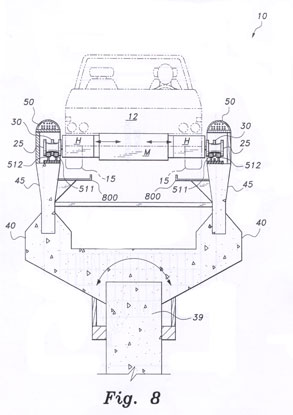What
Section Links: What | Glideway | Vehicle | Patent
The Bimodal Glideway project is a patented new highway system designed for vehicles that travel both on it and on the present highway and street system. Bimodal vehicles incorporate a system which allows them to enter onto a bimodal glideway and automatically convert to all electric, high speed vehicles. Riding on a single lane, grade separated glideway, each bimodal vehicle travels at high speed controlled by vehicle-glideway interacting systems. On existing roadways the vehicles operate conventionally.
This system moves traffic at the same density as a three lane highway. Traffic flows faster and more safely. Glideway automated vehicle control makes drive time free time for the “drive.”. The bimodal control system interacts with the glideway for maintaining precise velocity, location, and other functions. The system uses a unique vertical switching system, controlled acceleration, and system testing at each entrance. It includes an abort system in case of malfunction and redundancy for every critical component.
All traffic entering the main line enters from below, accelerates at a preset rate and enters the main line at a precise predetermined location in the flow of traffic at the design speed of the glideway. The bimodal glideway itself has no moving parts, no clover leaf intersections, only on and off ramps. All transfers to other glideways or surface highways occur in the street mode.
The glideway is a single lane with entrances and exits only - no crossings or stopping. All transitions to other glideways, streets, or highways are performed at the street level. All functions on the glideway are fully automated except for the driver notifying the vehicle which exit to use or in case of extreme emergencies. Each vehicle contains its own propulsion, controls, communications and active switching suspension sub-system. All sub-systems interact with the glideway controlling vehicle speed, location, relation to traffic, electricity pickup and configuring the suspension for exiting between the rails, down the off ramp, and returning to the street mode of travel.
Travelling on the glideway, vehicles ride between the tracks in single file at a constant velocity. They move in controlled grade-separated spaces so they can not fall off or veer into other traffic. This eliminates head-on collisions. The maximum speed of a glideway depends on its design, propulsion sub-system of the vehicles, and the electric power available. Speeds of over 100 MPH appear very practical. The elevated bimodal system integrates well with commercial transportation. The potential uses are enormous - supporting the U.S. postal system, light freight, automated parking facilities and bimodal rentals.
The Glideway will be developed through public/private partnerships. The final design of this system will require extensive collaboration and investment from the U.S. government and all associated industries. Public input from individuals and extra-governmental organizations is also essential. A major research, development and testing program will be necessary in order to achieve an optimized cost-beneficial effective system. The bimodal part of the vehicle would be designed tested and approved by a federal agency. The automobile industry would design, build, sell, and maintain the bimodal vehicles.
